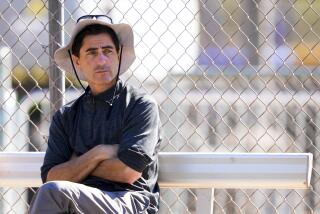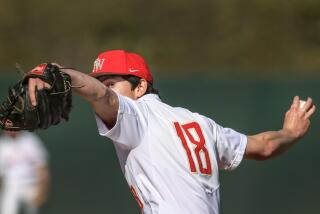As Pitcher, Gaspar Finds His Calling : Baseball: Capistrano Valley graduate started as an infield but now is Pepperdine’s No. 1 starter.
- Share via
MISSION VIEJO — Cade Gaspar held out as long as he could. He knew he had the arm of a potential pitching great, but from age 13 to 18 he ignored the call of the mound and played infield instead.
“I couldn’t stand pitching,” Gaspar, 20, said. “Everyone else loved being the pitcher, but I thought it was boring just throwing the ball. I’d rather be part of the action, be in plays, hit.”
With the exception of a few innings as a relief pitcher, Gaspar avoided the mound during his Capistrano Valley High School career. But when he reached Saddleback College, the forces of nature--and reason--began whittling away at his immunity.
When Saddleback Coach Jack Hodges saw the arm strength, the smooth throwing motion, the tall, lanky build, it was as if Gaspar’s body was crying out: Pitch me.
“Every scout who saw him said his future was on the hill--Cade even knew that,” Hodges said. “When he came here he told me, ‘I know I’m going to be a pitcher, but this may be my last year to play a position. Give me a shot.’ ”
Hodges did, and Gaspar earned the starting shortstop job in 1993. He hit .330 with a team-leading five home runs and also pitched 40 innings, mostly in relief, going 2-1 with a 1.67 earned-run average.
But when Gaspar reached Pepperdine this season, he knew he had to yield to common sense. The Houston Astros had offered a six-figure signing bonus in 1993, and not because they thought he’d be the next Cal Ripken Jr.
Judging from his first full season on the mound, his pitching career won’t be ending soon.
Gaspar, a 6-foot-3, 175-pound right-hander, began the season as a middle reliever but is now the Waves’ No. 1 starter. The sophomore is 5-1 with a 2.33 ERA and 60 strikeouts in 73 1/3 innings. Opponents are batting .192 against him.
Most impressed have been the pro scouts, who line the backstop with radar guns and marvel at his 90-m.p.h. fastball, sharp-breaking curve, and a lean frame they believe will fill out--and become even
stronger--in coming years.
Some believe Gaspar has the best arm on the West Coast, and Baseball America recently projected Gaspar as the eighth pick in the upcoming draft.
“That’s what they say, and I agree,” said Rod Gaspar, Cade’s father. “He’s one of the best in the country. Maybe I’m prejudiced, but I can’t imagine many kids having the stuff he has.”
Rod Gaspar knows more about baseball than your average dad. He played 10 years professionally, four in the major leagues, and was a reserve outfielder on the New York Mets’ 1969 World Championship team.
Rod ordered his son not to throw breaking balls when he was young.
“I’ve seen too many kids hurt their arms because they threw curveballs at an early age,” Gaspar said. “I wanted him to save his arm until he was older and stronger. He has a real fresh arm now, and that’s one thing the scouts like a lot.”
Cade didn’t turn many scouts’ heads in high school. He was a good defensive player on a very good Capistrano Valley team, which won the Southern Section 4-A championship in 1991, but he hit in the low .200s as a senior.
“I was horrible,” Cade said.
He wasn’t drafted after high school, and his only college offers were from Cal State Los Angeles and UC Irvine, which dropped baseball after the 1992 season.
“All I wanted was to play baseball, and I was real concerned after having such a bad year,” Gaspar said. “I went to Saddleback just hoping something would happen.”
Something did. It wasn’t good. On Jan. 30, 1992--the day before Gaspar was to pitch his first game at Saddleback--Cade’s 9-year-old brother, David, was diagnosed with leukemia.
Gaspar pitched the next day but lasted only 2 1/3 innings. His heart wasn’t in it. He quit the team to spend more time with his brother, who was confined to a bed in the UCLA Medical Center.
David had a rare, adult form of leukemia, and the disease virtually stormed his body. On April 11, only 2 1/2 months after the diagnosis, David died.
Cade still gets depressed when he thinks of David, whom he described as “the best athlete I’ve ever seen.” When David was 8, he was good enough to play in the highest Little League division, against 10-, 11- and 12-year-olds. But Cade has also tried to find strength in David’s memory.
“He’s one of my main motivations--I’ve dedicated the rest of my life to him,” Gaspar said. “I put his initials and number (3) in my hat. When I think of him, I think of how tough the kid was. He never complained, ever. I want to do the best I can for him, because he was the best.”
Though he pitched only 2 1/3 innings and wound up as a redshirt for the 1992 season, Gaspar was selected by the Astros in the 15th round in ’92. The Astros retained his rights until the 1993 draft, and toward the end of the ’93 season, Gaspar’s stock soared to the point that Houston was offering a first-round-caliber signing bonus.
But Pepperdine was Gaspar’s dream school--he followed the Waves’ run to the 1992 national championship--and when Coach Andy Lopez offered a scholarship, he jumped at it.
He told scouts he was going to college, but that didn’t stop the Yankees from using a late-round pick on him in 1993. Gaspar’s mind was made up, though, and it was off to Malibu, where early control problems relegated him to a middle relief role when this season started.
About a month into the season, Gaspar asked Lopez if he could start. He got a chance in a game March 9 against Cal State Fullerton, and responded with two innings of no-hit ball.
And to think, just three years ago Gaspar couldn’t stand the thought of pitching.
“Yeah, I’m glad to be pitching now,” Gaspar said. “I think I could have played a position in the pros, but I have a better future pitching. Hopefully I’ll get drafted by a National League team. It would be fun to be able to hit again.”
More to Read
Go beyond the scoreboard
Get the latest on L.A.'s teams in the daily Sports Report newsletter.
You may occasionally receive promotional content from the Los Angeles Times.











